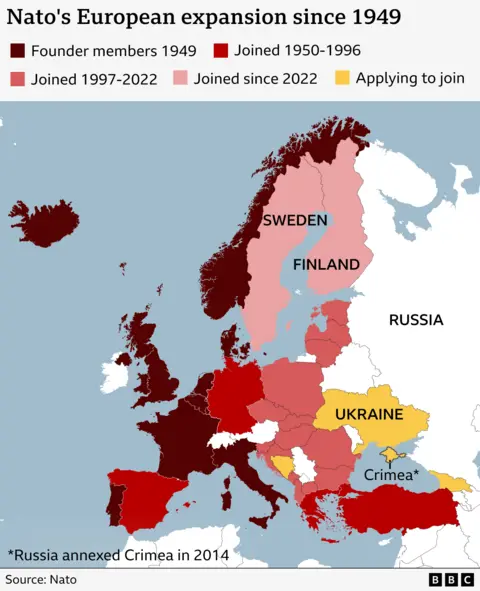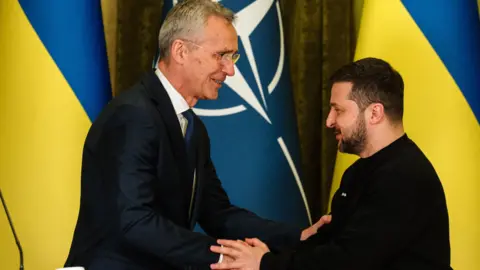Which countries are in Nato and how much do they spend on defence?
 Getty Images
Getty ImagesNato's 32 members have agreed to spend 5% of GDP on defence and security by 2035.
The move follows months of pressure from US President Donald Trump, who has repeatedly said European allies do not spend enough.
Speaking after the Nato Summit in the Hague, the leaders also restated their "ironclad commitment to collective defence", which is set out in Article 5 of Nato's founding treaty.
What is Nato and why was it set up?
Nato - the North Atlantic Treaty Organization - was formed in Washington DC in 1949 by 12 countries.
The founding members were Belgium, Canada, Denmark, France, Iceland, Italy, Luxembourg, the Netherlands, Norway, Portugal, the UK and the US.
 Getty Images
Getty ImagesNato's primary purpose was to block expansion in Europe by the former Soviet Union - a group of communist republics which included Russia.
Article 5 says members agree that if one of them is attacked, the others will help defend it.
Trump had earlier appeared to raise questions about the mutual defence guarantee, but Nato secretary general Mark Rutte insisted the US remained committed to the principle.
The alliance does not have its own army, but member states can take collective military action in response to international crises.
For instance, Nato supported the UN by intervening in the war in the former Yugoslavia between 1992 and 2004.
It also co-ordinates military plans and carries out joint military exercises.
Which countries are Nato members?
Nato has 32 members across Europe and North America - the original 12 founders plus 20 countries which have joined since 1949.
After the Soviet Union's collapse in 1991, many Eastern European countries became members, including Albania, Bulgaria, the Czech Republic, Estonia, Hungary, Latvia, Lithuania, Poland, Romania and Slovakia.

Finland - which has a 1,340km (832 mile) land border with Russia - joined in April 2023. Sweden became a member in March 2024.
Having been neutral for decades, both applied to Nato in May 2022, shortly after Russia invaded Ukraine.
Ukraine, Bosnia and Herzegovina, and Georgia have also asked to join.
How much do Nato members spend on defence?
Nato members are currently expected to spend 2% of their national income, or GDP on defence, although it is not a legally-binding commitment.
The US and countries which are close to Russia - such as Poland and the Baltic states - have traditionally spent the most.
The latest Nato estimates show nine members failed to meet the 2% target in 2024, with Spain spending the least.
The new split 5% target is widely seen as a concession to US President Donald Trump, who has repeatedly urged European Nato members to boost defence spending.
The latest figures show the US spent $935bn (£686bn) in 2024, which was 3.2% of its GDP and nearly double the defence spending of the rest of Nato put together.
Spain - which spent just 1.24% of GDP on defence in 2024 - had objected to the increased target before the summit. The Belgian and Slovakian governments also expressed concerns but ultimately accepted the increase.
In February, Sir Keir set out plans to increase the UK's core defence spending to 2.5% by April 2027 and expressed a "clear ambition" to reach 3% by 2034 if economic conditions allowed.
Ahead of the meeting in the Hague, the UK government said it will spend 2.6% on core defence and 1.5% on wider security measures by 2027. Core defence spending is not expected to hit 3.5% until the 2035 deadline.
It has not confirmed how it will fund the additional spending.
Why isn't Ukraine a member of Nato?
Russia has consistently opposed the idea of Ukraine becoming a member, fearing it would bring Nato forces too close to its borders.
However, in 2008, the alliance said that Ukraine could eventually join.
After Russia's invasion, Ukrainian President Volodymyr Zelensky asked for this process to be fast-tracked.
Former Nato chief Jens Stoltenberg said Ukraine could join "in the long term" but not until after the war ended.
 Getty
GettyHowever, speaking at a defence summit in Brussels in February 2025, Defence Secretary Hegseth said "the US does not believe that Nato membership for Ukraine is a realistic outcome of a negotiated settlement".
Some Nato defence chiefs pushed back against the comments.
Zelensky later said he was prepared to "give up" his presidency if it meant Ukraine could join Nato.
"If to achieve peace you really need me to give up my post, I'm ready," he told reporters.
"I can trade it for Nato membership."
Nato previously described Russia's invasion of Ukraine as the "most significant and direct threat to allies' security".
It has not sent troops to Ukraine or enforced a no-fly zone over the country for fear of being pulled into a direct conflict with Russia.
However, individual member states have supplied arms and equipment.
According to the German research organisation the Kiel Institute, the US spent 65bn euros (£55.6bn) on military support between February 2022 and April 2025 - although no new aid was allocated in March or April.
European Nato members provided aid worth 72bn euros (£61.6bn) over the same period.
